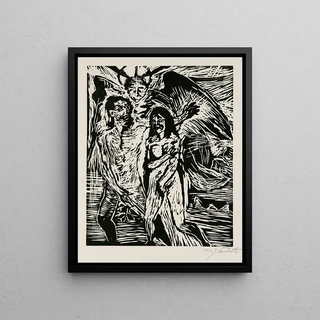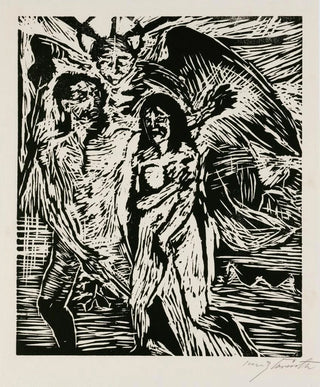Art print | Expulsion du paradis - Lovis Corinth


View from behind

Frame (optional)
The artwork "Expulsion from Paradise" by Lovis Corinth is a striking and evocative representation that immerses the viewer in a universe where spirituality and the human condition intersect. In this canvas, the artist captures a pivotal moment from Christian mythology, the expulsion of Adam and Eve from the Garden of Eden. This scene, filled with drama and emotion, is both a biblical narrative and a reflection on human nature, the quest for knowledge, and the consequences of our choices. The power of the colors and the dynamism of the forms invite deep contemplation, making this piece a true masterpiece in the history of art.
Style and uniqueness of the work
Lovis Corinth, a master of post-impressionism, stands out for his bold use of color and light. In "Expulsion from Paradise," he plays with striking contrasts that enhance the emotional intensity of the scene. The figures of Adam and Eve, depicted with palpable expressiveness, seem almost to emerge from the canvas, as if their despair and confusion transcend the frame. The composition, dynamic and swirling, reflects the inner turmoil of the characters, while the background, both vibrant and dark, evokes the passage from a world of purity to one of desolation. This work does not merely tell a story; it engages the viewer in a sensory and emotional experience, prompting reflection on universal themes of loss and redemption.
The artist and his influence
Lovis Corinth, born in 1858 in Prussia, is an emblematic figure of early 20th-century German art. His artistic journey is marked by constant evolution, oscillating between realism and expressionism. Corinth mastered the influences of great masters while developing a personal and inimitable style. His approach to painting, focused on expressing emotions and feelings, paved the way for many contemporary artists. By addressing mythological and biblical subjects, as in "Expulsion from Paradise," he fits within an artistic tradition while reinterpreting these stories through the prism of

Matte finish

View from behind

Frame (optional)
The artwork "Expulsion from Paradise" by Lovis Corinth is a striking and evocative representation that immerses the viewer in a universe where spirituality and the human condition intersect. In this canvas, the artist captures a pivotal moment from Christian mythology, the expulsion of Adam and Eve from the Garden of Eden. This scene, filled with drama and emotion, is both a biblical narrative and a reflection on human nature, the quest for knowledge, and the consequences of our choices. The power of the colors and the dynamism of the forms invite deep contemplation, making this piece a true masterpiece in the history of art.
Style and uniqueness of the work
Lovis Corinth, a master of post-impressionism, stands out for his bold use of color and light. In "Expulsion from Paradise," he plays with striking contrasts that enhance the emotional intensity of the scene. The figures of Adam and Eve, depicted with palpable expressiveness, seem almost to emerge from the canvas, as if their despair and confusion transcend the frame. The composition, dynamic and swirling, reflects the inner turmoil of the characters, while the background, both vibrant and dark, evokes the passage from a world of purity to one of desolation. This work does not merely tell a story; it engages the viewer in a sensory and emotional experience, prompting reflection on universal themes of loss and redemption.
The artist and his influence
Lovis Corinth, born in 1858 in Prussia, is an emblematic figure of early 20th-century German art. His artistic journey is marked by constant evolution, oscillating between realism and expressionism. Corinth mastered the influences of great masters while developing a personal and inimitable style. His approach to painting, focused on expressing emotions and feelings, paved the way for many contemporary artists. By addressing mythological and biblical subjects, as in "Expulsion from Paradise," he fits within an artistic tradition while reinterpreting these stories through the prism of






